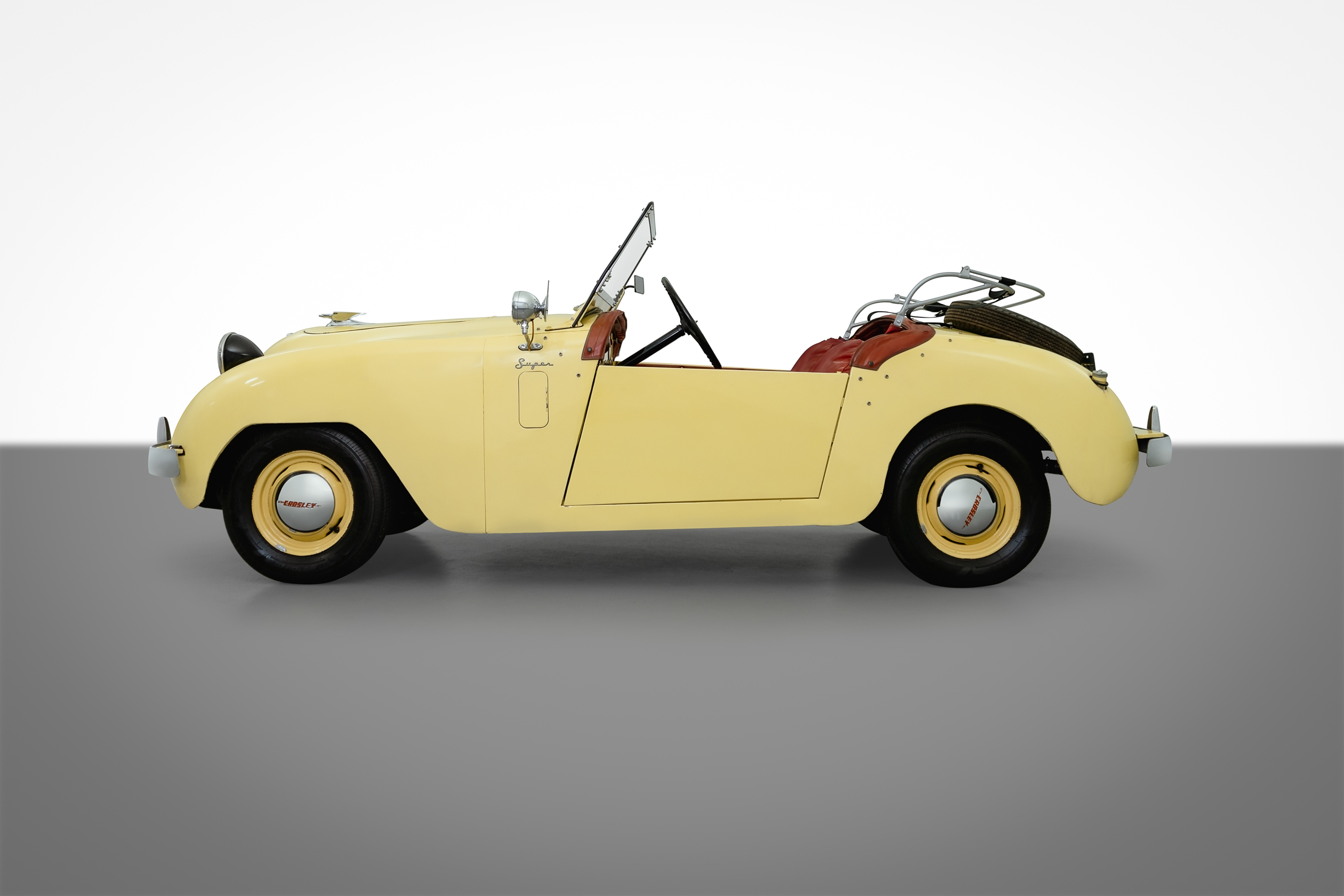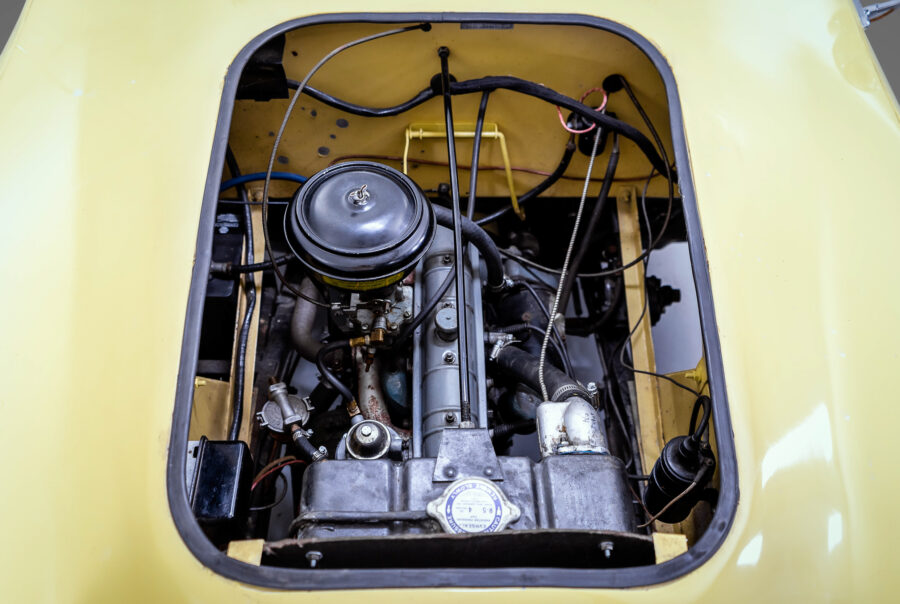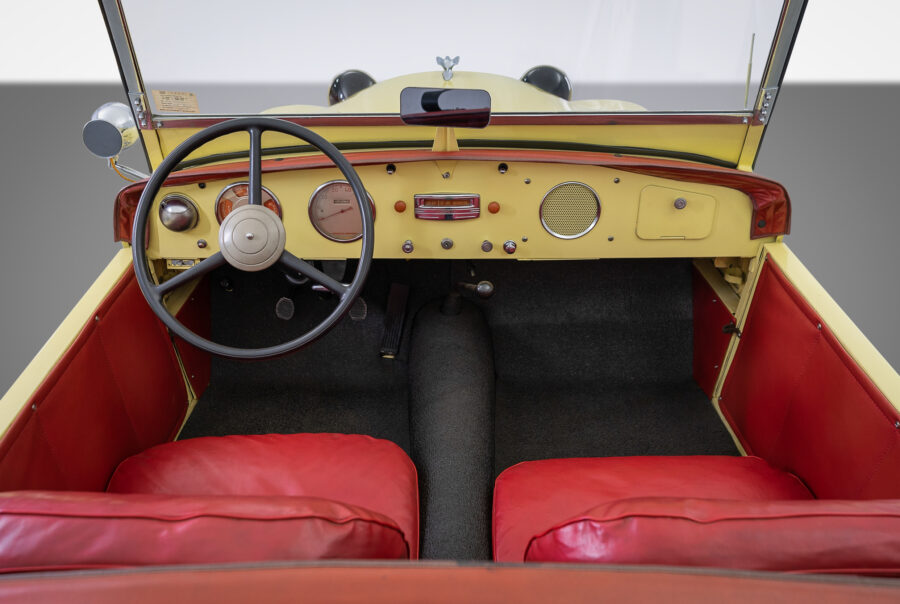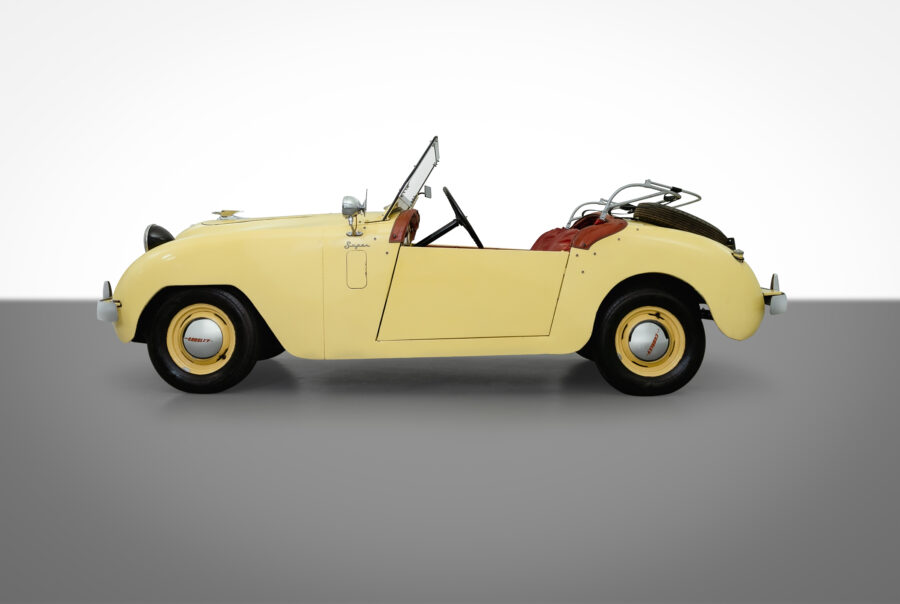

1951 Crosley Super Sport
Click any photo to view fullscreen. Mobile users can pinch to zoom. Tap ‘X’ to close.
SPEED
SPECIFICATIONS
- Mileage 09287.4
- Line 4cyl overhead cam
- 44 cui engine size
- Naturally Aspirated Tillotson Single Barrel Carburetor
- 6.2 Gallon Gas Tank
- 4 wheel caliper brakes
- 3-speed manual transmission
1951 Crosley Super Sport
The Crosley is a tiny little bit of an automobile from a short-lived Cincinnati automaker that produced microcars for those who eschewed the bigger-is-better trend of most US car buyers. The company built pint-sized sedans, wagons and convertibles from 1946-1952, following a brief startup in 1939 that ended when war began.
In 1949, Crosley introduced the minimalistic Hotshot roadster, a doorless sports car that weighed just over 1,000 pounds. The Super Sport version with doors and a folding top, rather than removable, entered the picture in 1950.
Based on the Hotshot, A Super Sport version of the HotShot was added in 1950, featuring solid hinged doors and a fold-down top that didn’t have to be stowed, and “full red plastic leather upholstery and lining”. For 1951 and 1952 the Super Hotshot was simply renamed the Super Sports.
This yellow Crosley Super Sport with a red interior is a “very interesting car to drive,” according to the Indianapolis dealer advertising the roadster on ClassicCars.com.
The diminutive sports car is powered by a 724cc overhead-valve inline-4-cylinder engine generating 26.5 horsepower and backed by a 3-speed manual transmission. Zero-to-60 time is rated at a brisk 20 seconds, “amazing for a car this size,” the seller notes.
“Pound for pound, some say the Crosley Super Sports is one of the greatest sports cars ever built,” the seller says.
Be that as it may, the Crosley is pretty much guaranteed to be a fun little runabout for those who appreciate great little cars, and it should attract lots of amused attention everywhere it goes. The Super Sport is a rare collector car today since not too many of them were sold in the first place.
While the seller does not reveal any details about the car’s history or restoration, the ad does note that it has been outfitted with a new fabric top and fresh tires on its 12-inch rims.
Regardless of its short life and small size, the Hotshot and Super Sport are remembered as impressive sports cars within their class. A Hotshot won the Sam Collier Memorial Endurance Grand Prix, (averaging 52 mph), as well as the “index of performance” — an award which took speed and engine size into account — at the 1950 Six Hours of Sebring; and a Siata 300 fitted with Crosley power won the SCCA’s 12 hour Vero Beach race.
Crosley Corporation
Powel Crosley Jr. made his fortune in the automotive parts and accessories business, before diversifying into manufacturing other consumer products and Crosley automobiles in the 1920s and 1930s. In 1925 his company became the largest manufacturer of radios in the world. The financial success of his manufacturing and radio broadcasting businesses provided the funds for Crosley to pursue his lifelong interest in manufacturing automobiles. He introduced the first Crosley compact car in 1939.
During World War II the Crosley company discontinued civilian automobile manufacturing and begin production of war-time materials, including development of experimental vehicles. In 1946 Crosley resumed production of compact and subcompact vehicles at its facility in Marion, Indiana, in addition to introducing new models and innovations to its offerings. After gas rationing was discontinued and the Big Three car makers began producing larger cars, consumer interest in Crosley’s compact cars declined. The last Crosley car rolled off the assembly line on July 3, 1952, and the company focused on its other, more successful business ventures.
Developer and Company Founder
Powel Crosley Jr. (September 18, 1886 – March 28, 1961) was an American inventor, industrialist, and entrepreneur. He was also a pioneer in radio broadcasting, and owner of the Cincinnati Reds major league baseball team. In addition, Crosley’s companies manufactured Crosley automobiles and radios, and operated WLW radio station. Crosley, once dubbed “The Henry Ford of Radio,” was inducted into the Automotive Hall of Fame in 2010 and the National Radio Hall of Fame in 2013.
He and his brother, Lewis M. Crosley, were responsible for many firsts in consumer products and broadcasting. During World War II, Crosley’s facilities produced more proximity fuzes than any other U.S. manufacturer, and made several production design innovations. Crosley Field, a stadium in Cincinnati, Ohio, was renamed for him, and the street-level main entrance to Great American Ball Park in Cincinnati is named Crosley Terrace in his honor. Crosley’s Pinecroft estate home in Cincinnati, Ohio, and Seagate, his former winter retreat in Sarasota, Florida are listed in the National Register of Historic Places.
It is notable that Crosley increased his fortune in the 1920s and 1930s by developing, manufacturing, selling inexpensive radios, such as the “Harko”, the Crosley “Pup” and the “Roamio” models. The Crosley Radio Corporation became the world’s largest radio manufacturer in 1925. It expanded operations at Camp Washington, a Cincinnati neighborhood, and began commercial radio broadcasting with WLW radio, considered “the Nation’s Station.” Crosley’s company also introduced new consumer products and home appliances in the 1930s, including the “Shelvador,” a refrigerator that had shelves in the doors, and other product innovations. The wealth that Crosley amassed from sales of these products provided the funds to diversify into other areas, including automobile manufacturing.





